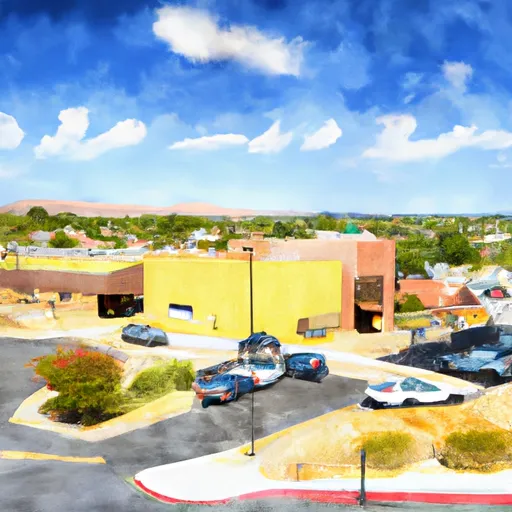-
 Snoflo Premium
Snoflo Premium
Get unlimited access to all our content
With no Ad interruptions! - Start Your Free Trial Login with existing account
Bowie
Eden Index
Climate
8.8
•
Recreation
2.2
•
Community
2.1
•
Safeguard
4.8/10

Bowie, Arizona is a small town located in the southeastern part of the state. The town has a semi-arid climate with hot summers and mild winters. The average annual rainfall is around 12 inches, which means water is a precious resource in this area. The local hydrology constituents are primarily focused on groundwater management and conservation. Outdoor recreation opportunities in Bowie include hiking, fishing, and hunting in nearby areas like the Chiricahua Mountains and the San Simon Valley. The area is also known for its birdwatching, with over 300 species of birds spotted in the region. Overall, Bowie offers a unique blend of natural beauty and outdoor activities for visitors and residents alike.
What is the Eden Index?
The Snoflo Eden Index serves as a comprehensive rating system for regions, evaluating their desirability through a holistic assessment of climate health, outdoor recreation opportunities, and natural disaster risk, acknowledging the profound impact of these factors on livability and well-being.
Climate Health Indicator (CHI): 8.8
Bowie receives approximately
293mm of rain per year,
with humidity levels near 46%
and air temperatures averaging around
18°C.
Bowie has a plant hardyness factor of
8, meaning
plants and agriculture in this region tend to thrive here all year round.
By considering the ideal temperature range, reliable water supplies, clean air, and stable seasonal rain or snowpacks, the Climate Health Indicator (CHI) underscores the significance of a healthy climate as the foundation for quality living.
A healthy climate is paramount for ensuring a high quality of life and livability in a region, fostering both physical well-being and environmental harmony. This can be characterized by ideal temperatures, reliable access to water supplies, clean air, and consistent seasonal rain or snowpacks.
Weather Forecast
Streamflow Conditions
Upper Gila
Area Rivers
Upper Gila
Snowpack Depths
Upper Gila
Reservoir Storage Capacity
Upper Gila
Groundwater Levels
Recreational Opportunity Index (ROI): 2.2
The Recreational Opportunity Index (ROI) recognizes the value of outdoor recreational options, such as parks, hiking trails, camping sites, and fishing spots, while acknowledging that climate plays a pivotal role in ensuring the comfort and consistency of these experiences.
Access to outdoor recreational opportunities, encompassing activities such as parks, hiking, camping, and fishing, is crucial for overall well-being, and the climate plays a pivotal role in enabling and enhancing these experiences, ensuring that individuals can engage in nature-based activities comfortably and consistently.
Camping Areas
| Campground | Campsites | Reservations | Toilets | Showers | Elevation |
|---|---|---|---|---|---|
| Hackel Road Dispersed | None | 3,026 ft | |||
| Bonita Canyon - Chiricahua National Monument | 22 | 5,334 ft | |||
| Cypress Park | 7 | 6,040 ft | |||
| Rucker Forest Camp | 14 | 6,195 ft | |||
| Rustler Park | 25 | 8,446 ft | |||
| West Turkey Creek | 7 | 5,911 ft | |||
| Pinery Canyon | 4 | 7,025 ft | |||
| Hot Well Dunes | 10 | 3,639 ft | |||
| Bathtub | 11 | 6,090 ft | |||
| Rucker Lake | 8 | 6,128 ft |
Nearby Ski Areas
Catastrophe Safeguard Index (CSI):
The Catastrophe Safeguard Index (CSI) recognizes that natural disaster risk, encompassing floods, fires, hurricanes, and tornadoes, can drastically affect safety and the overall appeal of an area.
The level of natural disaster risk in a region significantly affects safety and the overall livability, with climate change amplifying these risks by potentially increasing the frequency and intensity of events like floods, fires, hurricanes, and tornadoes, thereby posing substantial challenges to community resilience and well-being.
Community Resilience Indicator (CRI): 2.1
The Community Resilience Indicator (CRI) recognizes that education, healthcare, and socioeconomics are crucial to the well-being of a region. The CRI acknowledges the profound impact of these elements on residents' overall quality of life. By evaluating educational resources, healthcare accessibility, and economic inclusivity, the index captures the essential aspects that contribute to a thriving community, fostering resident satisfaction, equity, and social cohesion.

